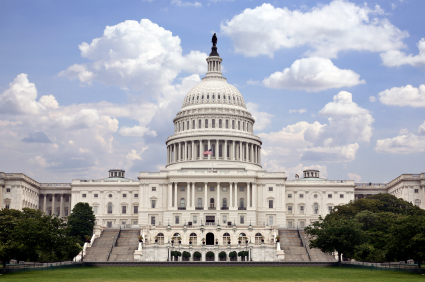
The U.S. Capitol, Capitol Hill is the home of the legislative branch of the federal government of the United States of America. The Capitol Building is at the center of the complex of buildings that include the six main congressional office buildings and the three buildings that house the Library of Congress.
Millions of people annually visit the building not only to lobby their Senators and Congressional representatives but to see the impressive architecture and artwork on display within the 175,170 square feet of ground covered by the sprawling structure.
Greek and Roman architecture combine in the design of the building which has been renovated on several occasions since construction. It was built between 1793 and 1829. The location for the building, 88 feet above the level of the Potomac River, was selected by the French architect Pierre L'Enfant at the center of the city grid he was charged with designing for the federation of States in 1791. L' Enfant did not design the building.
In 1800 Congress moved its permanent location to the U.S. Capitol, Capitol Hill, although construction of the building was incomplete. In 1814 the British set fire to the structure still under construction.
The building is 288 feet high, more than 750 feet long and 350 feet wide at its widest section. There are 540 rooms in all. The building has five floors in all.
Beneath the building runs a hub of activity that include the mail room, a series of administrative offices as well as a walkway and tram that shuttles Members of Congress and staffers from one side of the Hill to the other, avoiding the cold of the winter months when traveling between congressional office buildings and the Capitol Building.
The ground level is principally filled by rooms used by Congressional Officers and committee rooms. Visitors may see the Old Supreme Court Chamber, and the stunningly ornate decorations of the Brumidi Corridors on this floor as well as the historical exhibits in the Crypt that is located underneath the Rotunda.
On the second floor the Chambers of both the Senate and the House of Representatives are located as well as offices of the leadership of both bodies that make up the legislature. The visitor attractions focus on the circular Rotunda here, which is filled with art work telling the story of the nation's history. The ceiling rises more than 180 feet high in this vast space. To the south of the Rotunda is a hall of statues commemorating citizens that have played important roles in history. The old Senate Chamber is also on this floor and serves as a species of museum exhibit. The Senate has not met there since 1859.
From the third floor visitors can enter the galleries above both Chambers of Congress. Offices, press rooms and committee meeting rooms are also here.
The fourth floor houses other offices and administrative support areas.
Several Metro Stations are located right at Capitol Hill making it easy for visitors to arrive here. Tours are free but require passes which are available on a limited basis at the Visitor Center in the building for same day visits. Passes can also be obtained in advance. Tours are held on Mondays through Saturdays between 8:45 AM and 3:30 PM. The Visitor Center is open from 8:30 AM to 4:30 PM and is found in the Main Entrance. The Capitol is closed on Sundays, Thanksgiving Day, Christmas Day, New Year's Day, and Inauguration Day (every 4 years).
There are extensive provisions for accessibility that can be discussed with the Office of Congressional Accessibility Services prior to a visit by calling: 202-224-4048 (Voice) 202-224-4049 (TTY)